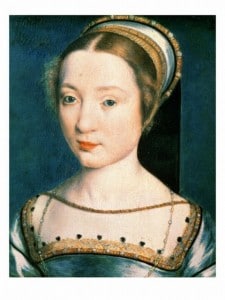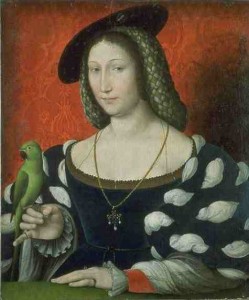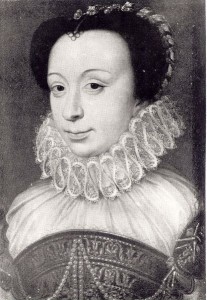
As I said in Part Three, it wasn’t just the Renaissance culture of her surroundings which influenced the young Anne Boleyn, she was also heavily influenced by the women she saw and spent time with in France. Let us look at some of the amazing women she met in France…
Claude of France
Claude was the eldest daughter of Louis XII of France and Anne of Brittany, who Pierre de Bourdeille, seigneur de Brantôme, described as “the most worthy and honourable queen that has ever been since Queen Blanche, mother of the King Saint-Louis, and very sage and virtuous”1. In his chapter on Anne of Brittany, Brantôme wrote of how “she was the first queen to hold a great Court of ladies”, a “noble school for ladies” where “she had them taught and brought up wisely; and all, taking pattern by her, made themselves wise and virtuous”2.
Claude was the heiress of the Duchy of Brittany and also to the throne, but, as I explained in Part Three, Salic Law prevented her becoming the Queen of France when her father died, instead she became queen by marrying Francis, Duke of Angoulême, who became Francis I of France.
Millicent Garrett Fawcett writes of how Claude “was from her birth delicate, plain and lame”3, and it is said that she was slightly hunch-backed, being a sufferer of scoliosis. Brantôme describes Queen Claude of France as “very good, very charitable, and very gentle to all, never doing any unkindness or harm to any one either at her Court or in the kingdom”4 and it is clear that she followed her mother’s example by running a virtuous and learned court. The virtuous, pious and kind Claude would have been a role model to Anne and I’m sure that Anne must have thought back to Claude’s behaviour as queen when she herself became queen, albeit in England, in 1533.
Claude’s husband, Francis I, was brought up at the Royal Château Amboise and he was often there during his reign (as well as Fontainebleau and the Louvre), living a life full of banquets, balls and tournaments. In 1515, Leonardo da Vinci was invited by Francis I to live and work in Clos Lucé which was connected to the Royal château by an underground passage. Queen Claude preferred nearby Château Blois, which Francis had renovated for her, and this is where Anne would have served her royal mistress.
Claude had seven children, including Henry II, King of France, but died in 1524 at the tender age of 24. Brantôme declared that Claude’s husband, Francis I, gave her “a disease that shortened her days”, meaning syphilis, but it is not known for certain although it was rumoured that the King’s death in 1547 was due to syphilis. It seems that after it had lost its pious queen the French court slid into debauchery.
Louise of Savoy
Louise of Savoy was the mother of Francis I and Marguerite of Angoulême (later Marguerite of Navarre), and the daughter of Philip II, Duke of Savoy, and Margaret of Bourbon. Louise, an intelligent, ambitious and politically astute woman, ensured that Francis and Marguerite had a Renaissance education and after the death of her husband, Charles of Orléans (cousin of Louis XII), she moved to the French court with her children, a move that was responsible for her son, Francis, becoming one of the King’s favourites and ensuring his succession to the throne. Louis XII gave Louise the royal château at Amboise where she brought up Francis and Marguerite.
Louise acted as Regent for Francis whenever he was away and, along with his sister Marguerite of Angoulême, was the most powerful woman at court, particularly in the early years of Francis’s reign. Between them they ran Francis’s court for him. Louise was serving as Regent in 1515, when Anne Boleyn was at the French Court, and Anne would have seen this strong, politically active woman run the country.

Marguerite of Angoulême
Brantôme’s chapter on Marguerite of France and Navarre is full of praise for the “perfect beauty”, the “rare princess” and a woman who “was full of majesty and eloquence… full of charming grace in gay and witty speech” and “a queen in all things”5, but who was Marguerite of Angoulême and Queen of Navarre?
Marguerite was the daughter of Louise of Savoy and Charles of Orléans, Count of Angoulême. Her mother, Louise, brought up her two children, Marguerite and her younger brother Francis, together, giving both of them an excellent Renaissance education, but, according to Millicent Garrett Fawcett, Marguerite soon outstripped her brother “in her knowledge of Greek, Latin and Hebrew, and in her easy grasp of modern languages.”6 But it wasn’t just education that Marguerite was passionate about, she also had “genuine religious fervour” and was passionate about the New Religion. As well as being known for her patronage of the arts, Marguerite is also known for her work “Le miroir l’âme pécheresse”, the same poem which Anne Boleyn’s daughter, Elizabeth, later translated as a gift for her stepmother, Catherine Parr. This wonderful literary work is a mystical poem which combines evangelical protestant ideas with Marguerite’s idea of her relationship with God as a very personal and familial one. In her poem, Marguerite sees God as her brother, father or lover. The editors of “Marguerite (Queen, consort of Henry II, King of Navarre): Selected Writings” say this of “Le Miroir”:-
“In addition to the obvious intimate familiarity with biblical literature, the poem follows closely the reformist views Marguerite learned from her mentor/confessor, Guillaume Briçonnet. Here we find all the essential earmarks of the devotio moderna, with its heavy emphasis on personal piety, exaggerated self-deprecation, preoccupation with death, and total dependence on divine grace for salvation”.7
You can read both the original French version and a translation of Le miroir at Google Books – click here. It is a beautiful piece of writing, very moving and obviously written from the heart, and it shows the depth of Marguerite’s faith and her personal relationship with God her Father.
Although Marguerite’s work was condemned as heresy, Fawcett writes of how Marguerite “never became a Protestant, and never separated herself from the Communion of the Church of Rome; the coarse violence of some of the manifestations of the Protestant movement disgusted and partially alienated her” but “she never wavered from the position she took up all through the years… of the protector of the new learning and the humble devotee of a religion which was pure and undefiled.”8 Couldn’t those same words be used to describe Anne Boleyn? I think so. Both women had a true faith, religious fervour, and were passionate about reform and new ideas, but they did not want to ‘throw the baby out with the bath water’. They wanted to reform the Catholic Church.
Fawcett goes on to describe German reformer, Philip Melancthon, as “a reformer after Margaret’s own heart, gentle and moderate, desiring to reconcile rather than to estrange; earnestly working for the reform of the Church from within so as to prevent the disruption of Christendom”9 and again I think of Anne Boleyn and wonder if she was influenced by Marguerite’s views and her faith.
But what was Anne Boleyn’s relationship with Marguerite?
We actually don’t know for sure. We know that Marguerite was influential at the French Court, sharing power in the early years of her brother’s reign with her mother, Louise of Savoy, so Anne Boleyn would have certainly met her. Some, including Herbert of Cherbury, have wondered whether Anne Boleyn actually served Marguerite as a lady-in-waiting, but there is no evidence of that and, according to Eric Ives10, Anne’s name does not appear in the “Comptes de Louise de Savoie et de Marguerite d’Angouleme” (the accounts), which you would expect if she was employed by Marguerite, and in 1522, on her departure from France, Anne was described as one of Queen Claude’s ladies. However, we have evidence that there was definitely some kind of relationship between the two women, two letters from Anne to Marguerite. In July 1534, instructions were given to Anne’s brother, Lord Rochford:-
“1. Rochford is to repair to the French king with all speed, and in passing by Paris to make the King’s and Queen’s hearty recommendations to the queen of Navarre, if she be there, and say that the Queen his mistress much rejoices in the deeply-rooted amity of the two kings, but wishes her to get the interview deferred, as the time would be very inconvenient to her, and the King is so anxious to see his good brother that he will not put it off on her account. Her reasons are, that being so far gone with child, she could not cross the sea with the King, and she would be deprived of his Highness’s presence when it was most necessary, unless the interview can be deferred till April next. Rochford is to press this matter very earnestly, and say that the King having at this time appointed another personage to go to his good brother, the Queen, with much suit, got leave for Rochford to go in his place, principally on this account.
2. That there was nothing she regretted at the last interview so much as not having an interview with the said queen of Navarre; and she hopes she may be able to come to Calais with her brother in April next, if the interview be deferred till then.”11
In September 1535, another message was sent to Marguerite saying that “The Queen[Anne Boleyn] said that her greatest wish, next to having a son, is to see you again”12
These words could simply be flattery and good diplomacy, but to me they sound like Anne was intimate with Marguerite, that they shared a friendship and that Anne was saddened to miss seeing Marguerite in 1534 and was really missing her in 1535.
Renée of France

Renée of France was Queen Claude’s younger sister and a woman known for her heretical beliefs. Millicent Garret Fawcett writes that Renée “partly through the influence of her cousin, Margaret of Angoulême, afterwards Queen of Navarre, and partly through that of her friend and governess, Madam de Soubise, was very favourable inclined to the reformed religion”13 and that when she became the Duchess of Ferrara she gathered around her “some of the most famous men and women of thought and letters in Europe”, people like Bernardo Tasso, Clément Marot, John Calvin, Rabelais, Vittorio Colonna (a friend of Michel Angelo), Lavinia della Rovere (great niece of Pope Julius II) the great Capuchin preacher Bernardino Ochino, and many more. Renée also used her power and status to protect reformers from persecution.
During her time in Ferrara, Renée was actually arrested as a heretic, although she escaped with her life after recanting and receiving the Eucharist at mass. However, after the death of her husband, the Duke of Ferrara, in 1559, Renée was able to return to her home country of France. In December 1560, her nephew, Francis II, died and the power of the Catholic Francis, Duke of Guise, was broken, enabling Renée to provide Protestant worship at her estate in Montargis. Her castle became a refuge for Protestants and she earned the praise of John Calvin himself for her efforts for the cause. Renée died on the 12th June 1574, aged 63 at her home in Montargis.
As the sister of Anne Boleyn’s mistress, Queen Claude, she is bound to have come into contact with Anne, and Retha Warnicke writes that Claude’s constant pregnancies meant that she, and therefore Anne, were “frequently in residence near Renée.”14 Warnicke is also of the opinion that Anne shared Renée’s schoolroom lessons, but if we believe that Anne was one of Claude’s ladies then she certainly would not have shared lessons with a princess. However, Renée was intimate enough with Anne to refer to their childhood friendship with Sir Nicholas Throckmorton, the English ambassador to France, during the reign of Anne’s daughter, Elizabeth I.
Diane de Poitiers
Diane de Poitiers was the daughter of Jean de Poitiers, Seigneur de Saint Vallier and Jeanne de Batarnay, and was an intelligent girl who was given a Renaissance Humanist education. She served Anne de Beaujeu, the eldest sister of Charles VIII of France, and while she was married to Louis de Brézé, seigneur d’Anet, she served Queen Claude and then Louise of Savoy. She was known for her beauty, intellect and wit, and also, later for being Henry II’s mistress. It is not known whether she and Anne Boleyn were close, but it is possible seeing as they both shared a love of learning and music, and they both served Queen Claude. Can you just imagine being a fly on the wall when Anne and Diane discussed art and music?
Conclusion
When you look at the education and experiences Anne had on the continent, and the women she mixed with from 1513 to 1522, you can understand why she had strong Reformist views, why she stood out at the English Court, why she caught Henry VIII’s eye and why he deemed her a worthy consort and mother of his children. Anne Boleyn had received a princess’s education, she had mixed with royalty and met Renaissance men and women, and she was an intelligent and ambitious woman. She was on Henry VIII’s wavelength, they understood each other and had shared interests and passions. I don’t believe that Anne seduced Henry or that she cast some kind of spell on him, or that she manipulated him into marriage, I believed that their relationship was a true meeting of minds and that they fell in love. What do you think?
Notes and Sources
- Illustrious dames of the court of the Valois kings, Pierre de Bourdeille, seigneur de Brantôme, the 16th century historian and biographer, p24
- Ibid., p30
- Five Famous French Women, Dame Millicent Garrett Fawcett (1905), p58
- Brantôme, p219
- Brantôme, p166
- M.G.Fawcett, p70
- Marguerite (Queen, consort of Henry II, King of Navarre): Selected Writings (Bilingual Edition) edited by Rouben Charles Cholakian, Mary Skemp, p73
- Fawcett, p81
- Ibid., p84
- The Life and Death of Anne Boleyn, Eric Ives, p32
- LP vii.958
- LP ix.378
- Fawcett, p251-252
- The Rise and Fall of Anne Boleyn, Retha Warnicke, p 21
ol>